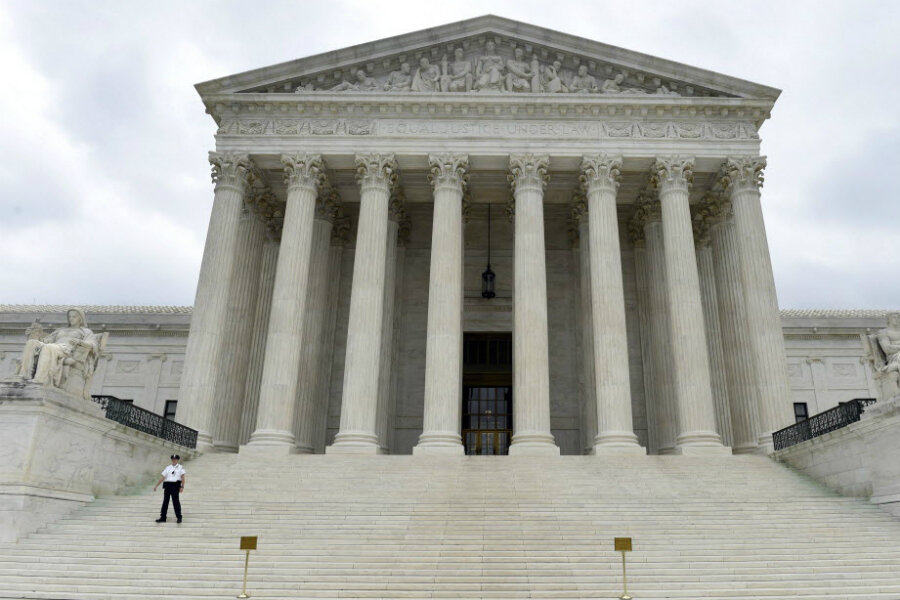Why Supreme Court sent key voting rights case back to Alabama
Loading...
| Washington
The Supreme Court on Wednesday sent a potentially important Alabama redistricting case back to a three-judge panel to reexamine whether the state legislature improperly relied on race when it redrew voting districts in 2012.
In a 5-to-4 decision, the high court vacated four main conclusions by the judicial panel. The majority justices refuted a finding that the Republican-controlled legislature did not violate the Constitution or the Voting Rights Act by concentrating African-American voters into voting districts that already contained a majority of African-American voters.
Writing for the majority, Justice Stephen Breyer said the judicial panel had operated under a “misperception of the law.”
At another point, Justice Breyer suggested that the lower court judges asked the wrong legal question. “Asking the wrong question may well have led to the wrong answer,” he said.
Some analysts suggest that the Alabama state legislature may move to draw a new election map, thus rendering the current case moot. Others suggest there may be more litigation in the future.
Nonetheless, the high court’s decision may offer useful guidance to those seeking to draw new district lines or challenge those new lines.
In his 23-page majority opinion, Breyer said the Alabama redistricting plan appeared to improperly rely on race as a predominant factor in drawing new voting district lines in 2012.
The majority justices rejected the explanation offered by the Alabama’s legislature that the districts were redrawn using a race-neutral criterion – to equalize the number of voters in each district.
The legislature had sought to justify its redistricting plan in part to re-establish an equal population among the state’s districts as a way to enforce the constitutional ideal of one person, one vote.
As part of that effort, lawmakers had shifted large numbers of African-American voters into districts that already contained a majority of black voters.
The redistricting was meant, in part, to undo the redistricting plan of an earlier Democrat-controlled legislature that sought to maximize Democratic voting clout by disbursing a large number of black voters into majority white districts. The disbursal left a number of African-American majority districts underpopulated relative to most other districts.
The lawmakers sought to correct that by requiring that the population in each districts throughout the state be within 2 percent of each other. To achieve that goal required moving voters from majority white districts back into majority black districts.
It is that movement that formed the center of the controversy.
Two minority groups sued, claiming that the state legislature had engaged in the forbidden practice of “packing” minority voters into certain districts to undercut their overall voting power.
The three-judge panel rejected that charge in a 2-to-1 decision. On Wednesday, the high court told the judicial panel to take another look.
Breyer said that state lawmakers are entitled to use a number of traditional race-neutral districting principles in redrawing district lines. They include compactness, contiguity, respect for political subdivisions, incumbency protection, and political affiliation.
But Breyer said an equal population objective was not on that list. He said it was merely a “background principle.”
He said once the equal population objective is put to the side, as a background principle, “then there is strong, perhaps overwhelming, evidence that race did predominate as a factor when the legislature drew the boundaries.”
He noted that state senate District 26 required the movement of 15,785 individuals into the newly drawn district – and that of that total only 36 were white.
The court said that the Alabama legislature relied on an improper mechanical use of percentages to determine if the new district lines excessively eroded minority voting clout. Instead, Breyer said, the proper test is to ask what percentage of minority voters is necessary in minority-majority districts to maintain the ability of minority voters to elect their candidates of choice.
In a dissent, Justice Antonin Scalia characterized the majority’s action as granting a “mulligan,” or do-over, to those challenging Alabama’s redistricting.
Justice Scalia said the challengers had pursued a flawed litigation strategy that should have doomed their case, but that the majority justices were offering them a “second bite at the apple.”
“Today, the Court issues a sweeping holding that will have profound implications for the constitutional ideal of one person, one vote, for the future of the Voting Rights Act of 1965, and for the primacy of the State in managing its own elections,” he wrote.
Joining Breyer in the majority were Justices Anthony Kennedy, Ruth Bader Ginsburg, Sonia Sotomayor, and Elena Kagan.
Scalia’s dissent was joined by Chief Justice John Roberts, and Justices Clarence Thomas and Samuel Alito.







